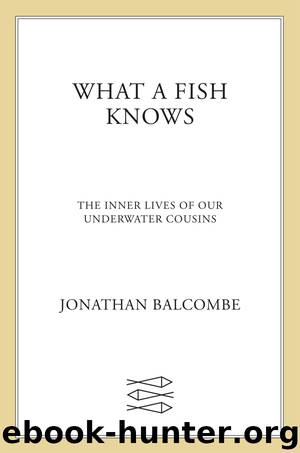What a Fish Knows by Jonathan Balcombe

Author:Jonathan Balcombe
Language: eng
Format: epub
ISBN: 9780374714338
Publisher: Farrar, Straus and Giroux
Dubious Dealings
Mucus nipping? Jolts? This is where the cleaner-client symbiosis gets more complicated, even Machiavellian. The cleaner-client symbiosis may seem neat and tidy—where everybody gains, and politeness and consideration for others reign supreme—but a system involving trust and goodwill is vulnerable to exploitation by parties with more selfish interests. As scientists have probed the cleaner-client mutualism more deeply, they have uncovered conflicting interests, and some dastardly deeds.
It turns out that what cleaners most like to glean from their clients is their mucus, which surprisingly has more nutritional value than algae and parasites. Plus it might just taste better. Needless to say, clients do not like having motes of mucus plucked from their bodies. A jolt happens when a client flinches as a cleaner nips at the protective mucus layer that surrounds a fish’s body. They may jolt because it hurts, but jolts also inform their cleaners that they bit what they shouldn’t have, and that the client knows it.
This conflict of interest between cleaners and clients has a cascade of consequences. Cleaners show extra consideration for clients in the early stages of their relationship. This includes giving them tactile stimulation. They do this by facing away from the client and stroking them with rapid movements of their pelvic and pectoral fins. This caressing behavior seems to be done for two reasons: (1) to encourage a client to stay longer at the cleaning station, and (2) to mollify a client following a jolt. Cleaners are more likely to caress a predaceous client, probably because it lowers the risk of an aggressive chase from a potentially dangerous customer. Hungry predaceous clients receive more caresses than satiated ones, regardless of the client’s parasite load. Perhaps there is a real danger of being chased and possibly caught and eaten by an irate client, though I am not aware of any diver having seen it happen.
Predaceous clients are much less aggressive in areas where cleanerfishes ply their trade, so these areas of a reef are considered safe havens. It makes sense that predators would want to be on their best behavior when they are among fishes who provide a valuable service other than as food. I expect also that the tactile stimulation of clients by cleaners has a pacifying effect.
Nevertheless, the great majority of client species are nonpredaceous, which means they lack the predatory client’s use of threat to convince a cleanerfish to clean more honestly and with more caresses.
So what’s a benign client to do? They have another strategy to keep cleaners on good behavior. It’s a sort of tit-for-tat arrangement. Prospective clients watch the performances of cleaners before deciding whether to let a particular cleaner inspect them. By doing this, client fishes accumulate—I’m not making this up—an “image score” for a given cleaner. Think of it as a fish’s version of eBay seller ratings. Mucus-nipping cleaners who cause more client jolts are shunned for more honest cleaners. This quality assurance system keeps things more virtuous. Cleaners have reputations, and they pay a price for transgressing into mucus nipping.
Download
This site does not store any files on its server. We only index and link to content provided by other sites. Please contact the content providers to delete copyright contents if any and email us, we'll remove relevant links or contents immediately.
Sapiens: A Brief History of Humankind by Yuval Noah Harari(13109)
The Tidewater Tales by John Barth(12045)
Do No Harm Stories of Life, Death and Brain Surgery by Henry Marsh(6349)
Mastermind: How to Think Like Sherlock Holmes by Maria Konnikova(6270)
The Thirst by Nesbo Jo(5814)
Why We Sleep: Unlocking the Power of Sleep and Dreams by Matthew Walker(5677)
Sapiens by Yuval Noah Harari(4574)
Life 3.0: Being Human in the Age of Artificial Intelligence by Tegmark Max(4534)
The Longevity Diet by Valter Longo(4462)
The Rules Do Not Apply by Ariel Levy(3928)
The Body: A Guide for Occupants by Bill Bryson(3849)
The Immortal Life of Henrietta Lacks by Rebecca Skloot(3840)
Why We Sleep by Matthew Walker(3794)
Animal Frequency by Melissa Alvarez(3769)
Yoga Anatomy by Kaminoff Leslie(3724)
Barron's AP Biology by Goldberg M.S. Deborah T(3643)
The Hacking of the American Mind by Robert H. Lustig(3595)
All Creatures Great and Small by James Herriot(3537)
Yoga Anatomy by Leslie Kaminoff & Amy Matthews(3419)
